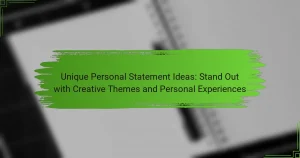
What are the Essential Elements of a Winning Personal Statement?
A winning personal statement contains several essential elements. First, a clear structure is vital. This includes an engaging introduction, a well-organized body, and a strong conclusion. The introduction should capture attention and set the tone. The body must detail experiences, achievements, and motivations. Each section should logically flow into the next.
Second, tone plays a crucial role. The tone should be professional yet personal. It should reflect authenticity and convey genuine passion. This helps create a connection with the reader.
Third, authenticity is key. A personal statement should reflect the true self of the writer. It should include personal anecdotes that illustrate growth and learning. This adds depth and relatability to the narrative.
These elements combined create a compelling personal statement that resonates with admissions committees.
How does Structure influence a Personal Statement?
Structure significantly influences a personal statement by organizing ideas clearly and logically. A well-defined structure helps the reader follow the writer’s narrative. It typically includes an introduction, body paragraphs, and a conclusion. Each section serves a specific purpose, guiding the reader through the applicant’s experiences and motivations. A strong introduction captures attention and sets the tone. Body paragraphs elaborate on key experiences, showcasing skills and attributes. A concise conclusion reinforces the applicant’s goals and aspirations. Research shows that clarity in writing enhances persuasiveness, making a structured personal statement more impactful.
What are the key components of a well-structured Personal Statement?
A well-structured Personal Statement includes several key components. First, an engaging introduction captures the reader’s attention. This section should present a personal anecdote or a compelling reason for pursuing the chosen field. Next, the body paragraphs elaborate on relevant experiences and skills. These experiences should demonstrate growth, commitment, and suitability for the program.
Additionally, each body paragraph should connect personal experiences to specific attributes of the program. This shows a clear understanding of what the program offers. Furthermore, a conclusion should summarize the main points and reiterate the applicant’s passion. It should also express enthusiasm for future contributions to the field.
Overall, clarity, coherence, and authenticity are essential throughout the statement. These components ensure that the Personal Statement effectively communicates the applicant’s unique story and aspirations.
How can the organization of ideas enhance clarity in a Personal Statement?
The organization of ideas enhances clarity in a Personal Statement by providing a logical flow of information. A clear structure allows readers to easily follow the writer’s thought process. This organization can include an introduction, body, and conclusion. Each section should serve a specific purpose. For instance, the introduction should present the main theme. The body should elaborate on experiences and qualifications. The conclusion should summarize key points and reinforce the main message. Research indicates that well-organized writing improves comprehension and retention. According to a study by the National Center for Reading First, organized texts lead to better understanding. Thus, clear organization is essential for effective communication in Personal Statements.
What role does Tone play in a Personal Statement?
Tone plays a crucial role in a personal statement. It shapes the reader’s perception of the applicant’s personality and intentions. A positive tone can convey enthusiasm and confidence. Conversely, a negative tone may suggest insecurity or lack of motivation. Consistency in tone helps maintain clarity and coherence throughout the statement. For example, a formal tone is often appropriate for academic applications. In contrast, a conversational tone may be suitable for creative fields. Ultimately, the right tone enhances the effectiveness of the narrative. It engages the reader and leaves a lasting impression.
How can the right Tone convey authenticity in a Personal Statement?
The right tone conveys authenticity in a personal statement by reflecting the writer’s genuine voice and emotions. A conversational tone invites readers to connect with the writer’s experiences. This connection fosters trust and relatability. Using personal anecdotes enhances the narrative and showcases individual perspectives. An authentic tone avoids clichés and formalities, making the writing more engaging. Research indicates that authenticity in personal statements can significantly impact admissions decisions. According to a study by the National Association for College Admission Counseling, 86% of admissions officers prioritize authenticity in applicants’ essays. Thus, the right tone is crucial for creating a sincere and impactful personal statement.
What are the different Tones that can be adopted in a Personal Statement?
A personal statement can adopt various tones. Common tones include formal, conversational, reflective, and passionate. The formal tone maintains professionalism and clarity. The conversational tone creates a more relatable and engaging narrative. The reflective tone allows for introspection and personal growth. The passionate tone conveys enthusiasm and commitment to the field of interest. Each tone serves to enhance the overall message and connect with the reader effectively.
Why is Authenticity crucial in a Personal Statement?
Authenticity is crucial in a personal statement because it reflects the true self of the applicant. Genuine expressions of personal experiences resonate with readers. Admissions committees seek candidates who are honest and self-aware. Authenticity builds trust and credibility in the narrative. It allows applicants to stand out among numerous submissions. A unique voice and perspective can enhance the overall impact. Studies show that personal statements with authentic narratives are more memorable. For instance, the University of California emphasizes the importance of personal voice in their admissions process.
How can one demonstrate authenticity in their writing?
To demonstrate authenticity in writing, one must express genuine thoughts and feelings. This involves using a personal voice that reflects true beliefs. Authentic writing resonates with readers because it is relatable and honest. Writers should share personal experiences to create a connection. Transparency about motivations and intentions enhances credibility. Additionally, avoiding clichés and generic phrases fosters originality. Research shows that authentic narratives engage readers more effectively. For instance, a study by the University of California found that personal storytelling increases reader empathy. Therefore, incorporating these elements consistently showcases authenticity in writing.
What common pitfalls should be avoided to maintain authenticity?
Common pitfalls to avoid in maintaining authenticity include exaggeration and insincerity. Exaggerating achievements can lead to distrust. Insincerity may alienate readers who value genuine expression. Additionally, using clichés dilutes personal narrative. Failing to reflect personal voice can make statements feel generic. Overemphasis on external validation can shift focus from personal growth. Ignoring feedback can result in a lack of perspective. Lastly, neglecting to connect experiences to core values undermines authenticity. These pitfalls compromise the integrity of personal statements, making them less impactful.

How can one effectively combine Structure, Tone, and Authenticity?
To effectively combine Structure, Tone, and Authenticity in a personal statement, one must ensure clarity and coherence. Structure provides a clear framework for ideas, guiding the reader through the narrative. A well-organized statement typically includes an introduction, body, and conclusion. Tone reflects the writer’s personality and should align with the message being conveyed. Authenticity involves being genuine and honest about experiences and motivations.
Using specific examples from personal experiences enhances authenticity. For instance, sharing a pivotal moment can illustrate personal growth. Maintaining a consistent tone throughout the statement reinforces the writer’s voice. This alignment helps create a compelling narrative.
Research shows that personal statements with clear structure and authentic tone resonate more with admissions committees. A study by the National Association for College Admission Counseling found that clarity and personal voice significantly impact the effectiveness of personal statements.
What strategies can enhance the integration of these elements?
To enhance the integration of structure, tone, and authenticity in a personal statement, one effective strategy is to create an outline first. This outline should clearly define how each element will be addressed. Next, use a consistent tone that reflects personal voice throughout the statement. Authenticity can be achieved by sharing personal anecdotes that illustrate key points. Additionally, revising the statement multiple times helps to ensure that all elements are cohesively woven together. Seeking feedback from peers or mentors can also provide insights on how well these elements are integrated. Incorporating these strategies leads to a more compelling and cohesive personal statement.
How do these elements work together to create a compelling narrative?
Structure, tone, and authenticity work together to create a compelling narrative in a personal statement. Structure provides a clear framework for presenting ideas logically. It guides the reader through the narrative, ensuring coherence and flow. Tone conveys the writer’s personality and emotions, making the narrative relatable and engaging. An appropriate tone resonates with the audience, enhancing emotional connection. Authenticity reflects genuine experiences and thoughts, establishing trust with the reader. When combined, these elements create a narrative that captivates and resonates, increasing the likelihood of leaving a lasting impression.

What are the best practices for crafting a winning Personal Statement?
The best practices for crafting a winning Personal Statement include clarity, authenticity, and tailored content. Clarity ensures that your message is easily understood. Authenticity allows your true self to shine through, making your statement memorable. Tailored content means customizing your statement for each application. Start with a strong opening that captures attention. Use specific examples to illustrate your experiences and achievements. Maintain a consistent tone that reflects your personality and aspirations. Proofread to eliminate errors and enhance professionalism. Following these practices increases the likelihood of making a positive impression on admissions committees.
What tips can help improve the overall quality of a Personal Statement?
To improve the overall quality of a Personal Statement, focus on clarity, authenticity, and structure. Start with a strong opening that captures attention. Use specific examples to illustrate your experiences and motivations. Maintain a consistent tone that reflects your personality. Organize your statement logically, with clear transitions between ideas. Avoid clichés and generic statements; be original. Proofread to eliminate grammatical errors and typos. Seek feedback from mentors or peers to gain perspective. These strategies enhance the impact of your Personal Statement, making it more compelling and memorable.
How can feedback from others enhance a Personal Statement?
Feedback from others can significantly enhance a Personal Statement by providing diverse perspectives. It helps identify strengths and weaknesses in content. Constructive criticism can clarify the message and improve coherence. Input from peers can ensure the tone aligns with the intended audience. Feedback may also reveal areas needing more detail or emotion. Engaging with mentors can highlight unique attributes that should be emphasized. Studies show that collaborative editing leads to higher quality writing. Overall, incorporating feedback fosters a more polished and authentic Personal Statement.
What resources are available for refining a Personal Statement?
Resources available for refining a Personal Statement include writing centers, online workshops, and peer review groups. Writing centers offer personalized feedback from trained professionals. Online workshops provide structured guidance and tips for effective writing. Peer review groups allow for collaborative critique and support among fellow applicants. Additionally, books and articles on personal statement writing can provide valuable insights and examples. Many universities also offer specific resources tailored to their application processes. These resources collectively enhance clarity, coherence, and impact in personal statements.
What common mistakes should be avoided in a Personal Statement?
Common mistakes to avoid in a Personal Statement include being overly generic. Generic statements fail to showcase individuality. They do not highlight personal experiences or unique perspectives. Another mistake is neglecting to proofread. Typos and grammatical errors can undermine professionalism. Additionally, failing to adhere to word limits is problematic. Exceeding limits can indicate a lack of respect for guidelines. A third mistake is using clichés. Phrases like “I have always wanted to help people” are unoriginal. Lastly, being too formal or impersonal can alienate the reader. A personal statement should reflect genuine voice and emotion.
The main entity of this article is the personal statement, specifically focusing on its essential elements such as structure, tone, and authenticity. The article outlines the importance of a clear structure that includes an engaging introduction, organized body, and strong conclusion, as well as the significance of maintaining a professional yet personal tone. It emphasizes the need for authenticity through personal anecdotes, showcasing genuine experiences and motivations. Additionally, the article provides strategies for effectively combining these elements to create a compelling narrative that resonates with admissions committees.




